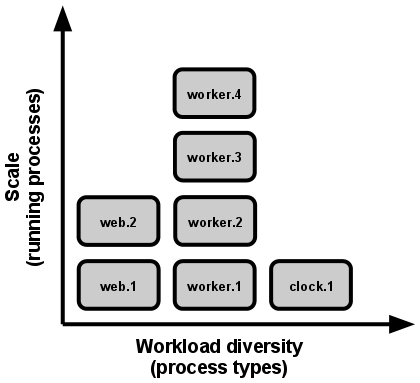In the modern era, software is commonly delivered as a service: called web apps, or software-as-a-service. The twelve-factor app is a methodology for building software-as-a-service apps that:
- Use declarative formats for setup automation, to minimize time and cost for new developers joining the project;
- Have a clean contract with the underlying operating system, offering maximum portability between execution environments;
- Are suitable for deployment on modern cloud platforms, obviating the need for servers and systems administration;
- Minimize divergence between development and production, enabling continuous deployment for maximum agility;
- And can scale up without significant changes to tooling, architecture, or development practices.
I. Codebase
One codebase tracked in revision control, many deploys
There is always a one-to-one correlation between the codebase and the app:

PS: The codebase is the same across all deploys, although different versions may be active in each deploy. For example, a developer has some commits not yet deployed to staging; staging has some commits not yet deployed to production. But they all share the same codebase, thus making them identifiable as different deploys of the same app.
II. Dependencies
Explicitly declare and isolate dependencies
A twelve-factor app never relies on implicit existence of system-wide packages. It declares all dependencies, completely and exactly, via a dependency declaration manifest.
Furthermore, it uses a dependency isolation tool during execution to ensure that no implicit dependencies “leak in” from the surrounding system. (e.x. Pip is used for declaration and Virtualenv for isolation) The full and explicit dependency specification is applied uniformly to both production and development.
III. Config
Store config in the environment
An app’s config is everything that is likely to vary between deploys (staging, production, developer environments, etc). This includes:
- Resource handles to the database, Memcached, and other backing services
- Credentials to external services such as Amazon S3 or Twitter
- Per-deploy values such as the canonical hostname for the deploy
Twelve-factor requires strict separation of config from code.
The twelve-factor app stores config in environment variables (often shortened to env vars or env).
In a twelve-factor app, env vars are granular controls, each fully orthogonal to other env vars. They are never grouped together as “environments”, but instead are independently managed for each deploy. This is a model that scales up smoothly as the app naturally expands into more deploys over its lifetime.
IV. Backing services
Treat backing services as attached resources
A backing service is any service the app consumes over the network as part of its normal operation. Examples include datastores (such as MySQL or CouchDB), messaging/queueing systems (such as RabbitMQ or Beanstalkd), SMTP services for outbound email (such as Postfix), and caching systems (such as Memcached).
The code for a twelve-factor app makes no distinction between local and third party services.
Each distinct backing service is a resource. Resources should be able to be attached to and detached from deploys at will.

V. Build, release, run
Strictly separate build and run stages
The twelve-factor app uses strict separation between the build, release, and run stages.

VI. Processes
Execute the app as one or more stateless processes
Twelve-factor processes are stateless and share-nothing. Any data that needs to persist must be stored in a stateful backing service, typically a database.
Some web systems rely on “sticky sessions” – that is, caching user session data in memory of the app’s process and expecting future requests from the same visitor to be routed to the same process. Sticky sessions are a violation of twelve-factor and should never be used or relied upon. Session state data is a good candidate for a datastore that offers time-expiration, such as Memcached or Redis. (Avoid process cache, stateful service.)
VII. Port binding
Export services via port binding
The twelve-factor app is completely self-contained and does not rely on runtime injection of a webserver into the execution environment to create a web-facing service. The web app exports HTTP (or other web transportation protocol) as a service by binding to a port, and listening to requests coming in on that port.
Port binding is typically implemented by using dependency declaration to add a webserver library to the app.
Note also that the port-binding approach means that one app can become the backing service for another app, by providing the URL to the backing app as a resource handle in the config for the consuming app.
VIII. Concurrency
Scale out via the process model
In the twelve-factor app, processes are a first class citizen. Processes in the twelve-factor app take strong cues from the unix process model for running service daemons. Using this model, the developer can architect their app to handle diverse workloads by assigning each type of work to a process type.

IX. Disposability
Maximize robustness with fast startup and graceful shutdown
The twelve-factor app’s processes are *disposable*, meaning they can be started or stopped at a moment’s notice.
Processes shut down gracefully when they receive a SIGTERM signal from the process manager. For a web process, graceful shutdown is achieved by ceasing to listen on the service port (thereby refusing any new requests), allowing any current requests to finish, and then exiting. Implicit in this model is that HTTP requests are short (no more than a few seconds), or in the case of long polling, the client should seamlessly attempt to reconnect when the connection is lost.
Processes should strive to minimize startup time. Processes should also be robust against sudden death, in the case of a failure in the underlying hardware.
X. Dev/prod parity
Keep development, staging, and production as similar as possible
The twelve-factor app is designed for continuous deployment by keeping the gap between development and production small.
The twelve-factor developer resists the urge to use different backing services between development and production, even when adapters theoretically abstract away any differences in backing services.
XI. Logs
Treat logs as event streams
A twelve-factor app never concerns itself with routing or storage of its output stream. It should not attempt to write to or manage logfiles. Instead, each running process writes its event stream, unbuffered, to
stdout.
During local development, the developer will view this stream in the foreground of their terminal to observe the app’s behavior.
In staging or production deploys, each process’ stream will be captured by the execution environment, collated together with all other streams from the app, and routed to one or more final destinations for viewing and long-term archival. These archival destinations are not visible to or configurable by the app, and instead are completely managed by the execution environment.
XII. Admin processes
Run admin/management tasks as one-off processes
Developers will often wish to do one-off administrative or maintenance tasks for the app. (e.x. manage.py migrate in
Django). One-off admin processes should be run in an identical environment as the regular long-running processes of the app. They run against a release, using the same codebase and config as any process run against that release. Admin code must ship with application code to avoid synchronization issues.
Reference
[1]. https://12factor.net/